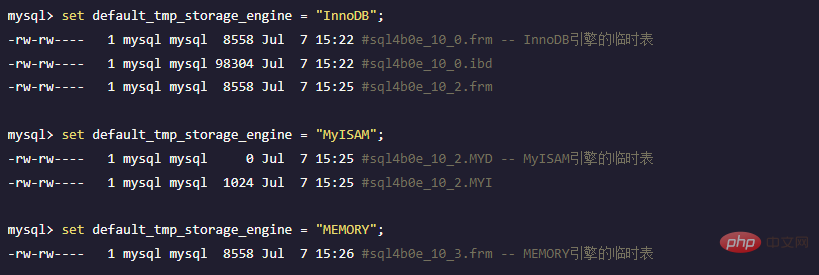When to use temporary table in mysql
When using temporary tables in mysql: 1. When using the TEMPTABLE algorithm or the view in the UNION query; 2. When using the DISTINCT query and adding ORDER BY; 3. When using "SQL_SMALL_RESULT" in SQL " option; 4. When using the subquery in FROM, etc.

The operating environment of this tutorial: windows10 system, mysql8.0.22 version, Dell G3 computer.
When to use temporary tables in mysql
MySQL will create temporary tables in the following situations:
1. UNION query;
2. Use the TEMPTABLE algorithm or the view in the UNION query;
3. When the clauses of ORDER BY and GROUP BY are different;
4. In table connection, ORDER The column of BY is not in the driver table;
5. When querying DISTINCT and adding ORDER BY;
6. When the SQL_SMALL_RESULT option is used in SQL;
7. Subquery in FROM;
8, subquery or table created during semi-join;
EXPLAIN Check the Extra column of the execution plan result. If it contains Using Temporary, it means it will be used. Temporary tables.
Of course, if the amount of data that needs to be stored in the temporary table exceeds the upper limit (tmp-table-size or max-heap-table-size, whichever is greater), then you need to generate a disk-based Temporary table.
In the following situations, a disk temporary table will be created:
1. The data table contains BLOB/TEXT columns;
2. In the columns of GROUP BY or DSTINCT, there are character type columns exceeding 512 characters (or binary type columns exceeding 512 bytes, before 5.6.15, only whether it exceeds 512 bytes);
3. In SELECT , UNION, UNION ALL queries, there are columns with a maximum length exceeding 512 (512 characters for string types, 512 bytes for binary types);
4. Execute SHOW COLUMNS/FIELDS and DESCRIBE Wait for SQL commands because their execution results use the BLOB column type.
Starting from 5.7.5, there is a new system option internal_tmp_disk_storage_engine that can define the engine type of the disk temporary table as InnoDB. Before this, only MyISAM could be used. The new system option default_tmp_storage_engine added after 5.6.3 controls the engine type of the temporary table created by CREATE TEMPORARY TABLE. In the past, the default was MEMORY. Do not confuse the two.
See the following example:

Recommended learning: mysql video tutorial
The above is the detailed content of When to use temporary table in mysql. For more information, please follow other related articles on the PHP Chinese website!

Hot AI Tools

Undresser.AI Undress
AI-powered app for creating realistic nude photos

AI Clothes Remover
Online AI tool for removing clothes from photos.

Undress AI Tool
Undress images for free

Clothoff.io
AI clothes remover

Video Face Swap
Swap faces in any video effortlessly with our completely free AI face swap tool!

Hot Article

Hot Tools

Notepad++7.3.1
Easy-to-use and free code editor

SublimeText3 Chinese version
Chinese version, very easy to use

Zend Studio 13.0.1
Powerful PHP integrated development environment

Dreamweaver CS6
Visual web development tools

SublimeText3 Mac version
God-level code editing software (SublimeText3)

Hot Topics
 1669
1669
 14
14
 1428
1428
 52
52
 1329
1329
 25
25
 1273
1273
 29
29
 1256
1256
 24
24
 Laravel Introduction Example
Apr 18, 2025 pm 12:45 PM
Laravel Introduction Example
Apr 18, 2025 pm 12:45 PM
Laravel is a PHP framework for easy building of web applications. It provides a range of powerful features including: Installation: Install the Laravel CLI globally with Composer and create applications in the project directory. Routing: Define the relationship between the URL and the handler in routes/web.php. View: Create a view in resources/views to render the application's interface. Database Integration: Provides out-of-the-box integration with databases such as MySQL and uses migration to create and modify tables. Model and Controller: The model represents the database entity and the controller processes HTTP requests.
 MySQL and phpMyAdmin: Core Features and Functions
Apr 22, 2025 am 12:12 AM
MySQL and phpMyAdmin: Core Features and Functions
Apr 22, 2025 am 12:12 AM
MySQL and phpMyAdmin are powerful database management tools. 1) MySQL is used to create databases and tables, and to execute DML and SQL queries. 2) phpMyAdmin provides an intuitive interface for database management, table structure management, data operations and user permission management.
 MySQL vs. Other Programming Languages: A Comparison
Apr 19, 2025 am 12:22 AM
MySQL vs. Other Programming Languages: A Comparison
Apr 19, 2025 am 12:22 AM
Compared with other programming languages, MySQL is mainly used to store and manage data, while other languages such as Python, Java, and C are used for logical processing and application development. MySQL is known for its high performance, scalability and cross-platform support, suitable for data management needs, while other languages have advantages in their respective fields such as data analytics, enterprise applications, and system programming.
 Laravel framework installation method
Apr 18, 2025 pm 12:54 PM
Laravel framework installation method
Apr 18, 2025 pm 12:54 PM
Article summary: This article provides detailed step-by-step instructions to guide readers on how to easily install the Laravel framework. Laravel is a powerful PHP framework that speeds up the development process of web applications. This tutorial covers the installation process from system requirements to configuring databases and setting up routing. By following these steps, readers can quickly and efficiently lay a solid foundation for their Laravel project.
 Explain the purpose of foreign keys in MySQL.
Apr 25, 2025 am 12:17 AM
Explain the purpose of foreign keys in MySQL.
Apr 25, 2025 am 12:17 AM
In MySQL, the function of foreign keys is to establish the relationship between tables and ensure the consistency and integrity of the data. Foreign keys maintain the effectiveness of data through reference integrity checks and cascading operations. Pay attention to performance optimization and avoid common errors when using them.
 Compare and contrast MySQL and MariaDB.
Apr 26, 2025 am 12:08 AM
Compare and contrast MySQL and MariaDB.
Apr 26, 2025 am 12:08 AM
The main difference between MySQL and MariaDB is performance, functionality and license: 1. MySQL is developed by Oracle, and MariaDB is its fork. 2. MariaDB may perform better in high load environments. 3.MariaDB provides more storage engines and functions. 4.MySQL adopts a dual license, and MariaDB is completely open source. The existing infrastructure, performance requirements, functional requirements and license costs should be taken into account when choosing.
 SQL vs. MySQL: Clarifying the Relationship Between the Two
Apr 24, 2025 am 12:02 AM
SQL vs. MySQL: Clarifying the Relationship Between the Two
Apr 24, 2025 am 12:02 AM
SQL is a standard language for managing relational databases, while MySQL is a database management system that uses SQL. SQL defines ways to interact with a database, including CRUD operations, while MySQL implements the SQL standard and provides additional features such as stored procedures and triggers.
 What software is better for yi framework? Recommended software for yi framework
Apr 18, 2025 pm 11:03 PM
What software is better for yi framework? Recommended software for yi framework
Apr 18, 2025 pm 11:03 PM
Abstract of the first paragraph of the article: When choosing software to develop Yi framework applications, multiple factors need to be considered. While native mobile application development tools such as XCode and Android Studio can provide strong control and flexibility, cross-platform frameworks such as React Native and Flutter are becoming increasingly popular with the benefits of being able to deploy to multiple platforms at once. For developers new to mobile development, low-code or no-code platforms such as AppSheet and Glide can quickly and easily build applications. Additionally, cloud service providers such as AWS Amplify and Firebase provide comprehensive tools




